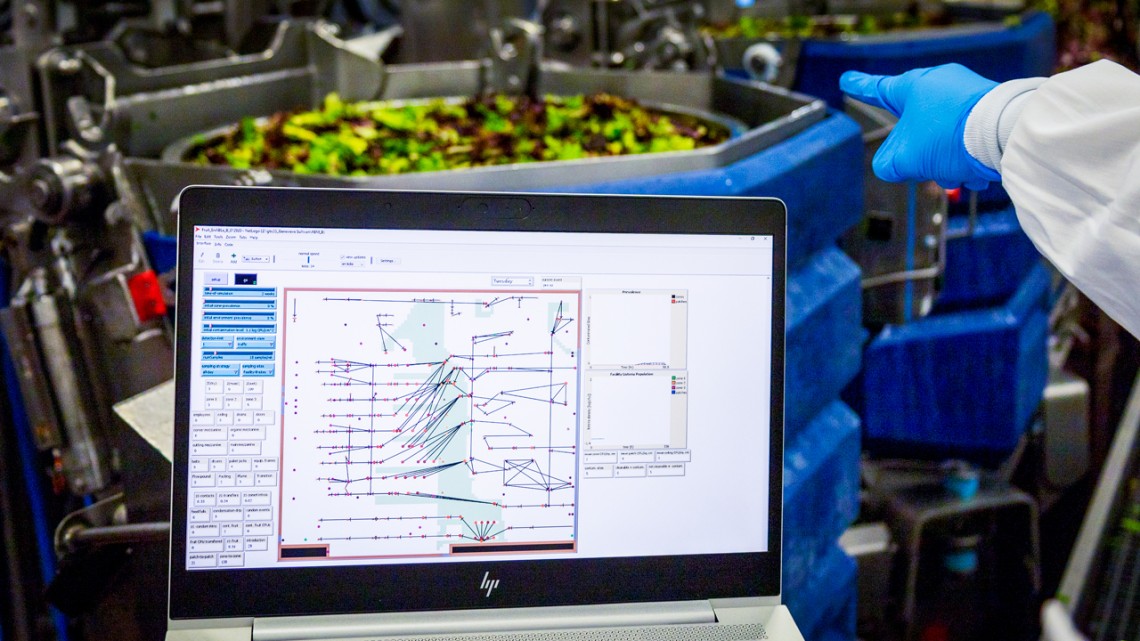
A spinach weigher in a fresh-cut produce facility that has a ‘digital twin.’
Sim City for food science takes on Listeria outbreaks
By Melanie Greaver Cordova
Researchers from Cornell are blending food science expertise and computer programming savvy to help the food industry stop Listeria outbreaks.
Listeriosis, an infection caused by eating food contaminated by the bacterium Listeria monocytogenes, causes approximately 260 deaths and 1,600 infections each year. If certain foods aren’t pasteurized, cooked thoroughly enough or washed properly, the bacteria can take hold and cause severe illness, including brain infections.
In a new study, the researchers developed a “digital twin” of two fresh-cut produce facilities, using these digital models to identify the optimal times and locations to look for the bacteria’s presence and therefore prevent food contamination.
“Our findings are another step forward in equipping food producers with science-based tools to manage food safety risks,” said Renata Ivanek, Ph.D. ’08, associate professor at the College of Veterinary Medicine and senior author on the paper.
The researchers’ model provides a novel way for food safety managers to first visualize microbial contamination risks and patterns in their operations, and then to experiment with different environmental sampling practices, such as collecting sponge samples from different pieces of equipment.
Because of the complexity of these facilities, experimenting in the actual environment is not always practical, and by using a digital twin, each facility can personalize its unique features. “For example, in the two facilities we modeled in this study, we wanted to find when sampling certain types of locations would be more beneficial than sampling random locations, and vice versa,” Ivanek said.
The study was published Oct. 14 in the Journal of Applied and Environmental Microbiology. Co-authors include Genevieve Sullivan ’16, Ph.D. ’20; Martin Wiedmann, Ph.D. ’97, the Gellert Family Professor in Food Safety in the College of Agriculture and Life Sciences; and Claire Zoellner, Ph.D. ’17. Zoellner currently works for a software company that is licensing this technology for commercialization so food processors can more easily access the model to optimize their sampling.
The next step in this research will develop similar models for produce packing houses as well as grocery stores. Ultimately, the authors hope to provide the food industry with digital twins that can be updated with real-time data, and can use simulation, modeling and machine learning to help workers make decisions about food safety hazards.
“For this vision to become reality, there is also a great need to ensure secure and confidential data sharing among food production businesses, and also to regulate liabilities from using such tools,” Ivanek said.
This study is part of a larger, multi-institutional effort to develop digital decision support tools for various parts of the food system, from farm to retail, with the ultimate goal of developing systems models and digital twins that will improve food safety decision-making system-wide.
“The learning curve needed to develop such models is steep, requiring understanding of food systems and food safety on the one hand and computer programing on the other,” Ivanek said. “There is a great need for cross-training between food safety and computer science disciplines and we hope our scholarship encourages that.”
This study was supported by the Center for Produce Safety, USDA’s National Institute of Food and Agriculture, the Florida Department of Agriculture and Consumer Services, and the Washington State Department of Agriculture.
Melanie Greaver Cordova is assistant director of communications for the College of Veterinary Medicine.
Media Contact
Get Cornell news delivered right to your inbox.
Subscribe
